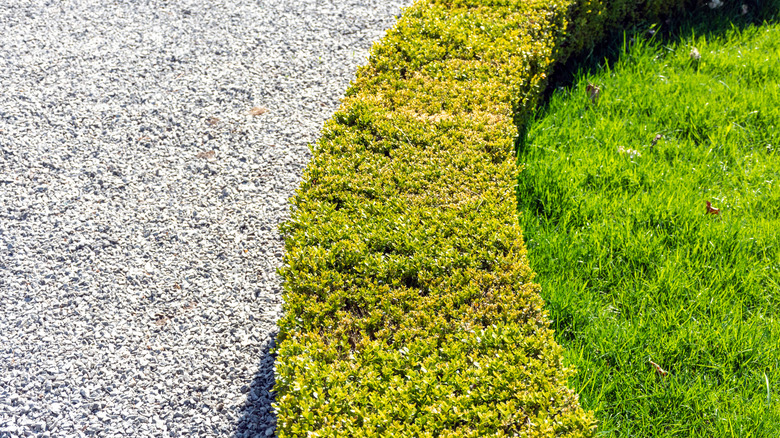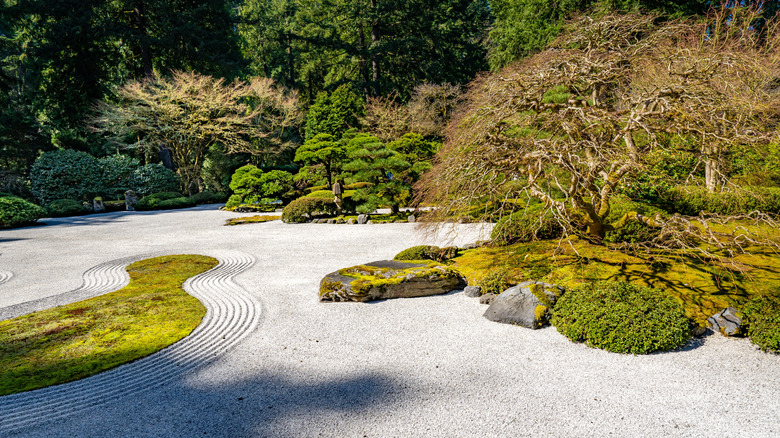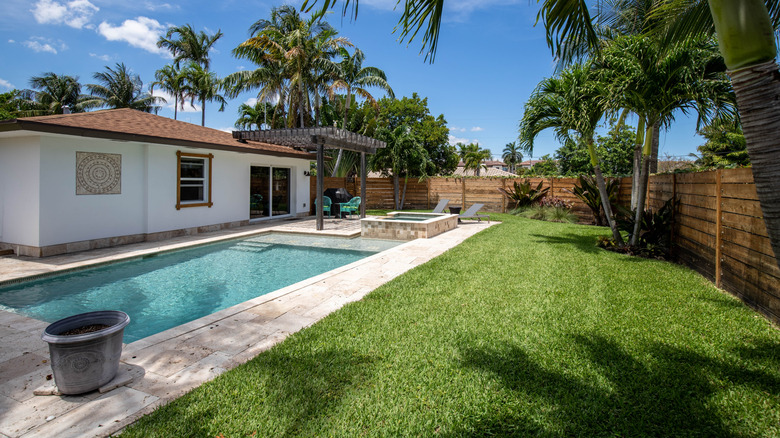Pea Gravel Vs Grass: Which Is The Better Buy For A Luxe Backyard Design?
So, you're looking to refresh your backyard landscape on a budget. The goal? Turn it into the ultimate luxurious retreat. As you might have noticed, most luxe backyard designs feature some sort of water feature, a cozy seating area, strategically placed plants, but most importantly, a stylish floor to "ground" everything. Enter pea gravel and grass. Well-maintained, these landscaping materials can uplift the entire look of a garden. Check out the Gardens of Versailles for proof. Of course, they both have their own sets of cons. So, we asked Sara Bendrick, Owner of Sarita Landscapes, HGTV Host, and National Spokesperson for STIHL Inc., for expert advice on which is the better buy for a luxe backyard design.
"Grass is always a classic choice," Bendrick revealed in her exclusive interview with House Digest. "However, depending on where you live, watering it might cost a lot over time." Then, we have pea gravel with its crunchy texture and rustic charm. "Think European inspired, by greeting patio spaces with bistro tables, surrounded by ornamental grasses or flowering shrubs," the expert noted. Cover the whole garden in nothing but pea gravel, though, and it'll just look dull.
Fortunately, the two aren't too far apart cost-wise, in case you want both. "Sod prices will vary depending on the type, availability in the season, but you can expect a cost of $4-$7 for installed sod," Bendrick said. The same can be said for pea gravel, which also typically ranges from $4 to $7 per square foot. Whatever your pick, don't forget to factor "demolition [and] perforation" costs into your budget as well.
The pros and cons of pea gravel
Again, there's no denying the aesthetic appeal and versatility of pea gravel. You could lay it over your patio, turn it into a pathway, or even use it as edging along your backyard — not to mention all the colors it's available in. Consider white if your exterior leans on the modern side. Or, choose something like tan, red, and brown for a country feel. You could even buy multi-colored gravel to amp up the visual interest. "Gravel is wonderfully affordable and can give such a great look in your yard," Sara Bendrick exclusively told House Digest.
There are just a few drawbacks to consider, including the fact that it can easily shift. "If the gravel is more round than angular, it moves when you walk on it," Bendrick pointed out, also noting that "it can be pushed out of the way by running dogs." To prevent that, the landscape designer suggests picking a more angular pea gravel so it stays in place better.
Another reason why you should think twice before using pea gravel in your landscape is the maintenance involved. While not as frequent as grass, it can still be laborious to maintain once it's time to pull out the rake. "Over time your landscape fabric that separates it from pressing into the dirt might wear out, and you'll need to rake up the gravel to replace the fabric," Bendrick explained. Pesky weeds might also be a concern, but she said "this seems to be more of a problem for people who don't maintain their space occasionally or regularly."
The pros and cons of grass
Everyone loves grass for one reason or another. Some like it for its soft feel underfoot; others find the touch of greenery calming. But that's not all this landscaping material has to offer in a garden. "[Grass] helps cool the surrounding area, it's a great firebreak, and overall it makes the most versatile usable areas for play, picnics, and naps," Sara Bendrick shared in her exclusive interview with House Digest. Let's not forget grass promotes a healthy ecosystem, too!
The major downside is obviously maintenance, which involves removing weeds, watering, trimming, and raking year-round. "While you should mow once a week or so, you could also opt for new robot mowers to do the work for you," the landscaper advised. Her suggestion? The iMOW® 6 EVO robotic mower from STIHL. This little guy not only gets the job done fast, but it also saves you money in the long run since you won't have to hire someone to mow your lawn as much.
Another (more affordable) option is to hack your way to a low-maintenance grass garden. "You could consider doing more of a meadow grass, which gives an elevated look while also taking less water and less mowing maintenance," Bendrick revealed. Just keep in mind, there are some types of grasses that you should plant for a lush, green lawn and others that should be avoided at all costs.


